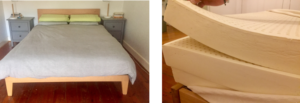Your bed and especially your mattress are without a doubt the most important pieces of furniture in your home. It may not automatically seem to be the highest priority because it’s not a focal point in your home, but let’s consider what we use our bed for. Firstly, in terms of the amount of time we spend there, its approximately one third of our life that we spend lying on our beds. Secondly, the primary reason we’re spending so much time in our bedrooms and beds is to retreat, rest, sleep, renew, detoxify and for our bodies to recover for the next day. However, the reality is that often the bed is a source of allergens and toxic chemicals.
We’ve recently purchased a new mattress and bed base and it was a reminder of the minefield of choices, lack of information and labeling and conflicting messages around the best option. Our main goals for our purchase were to support my challenges around environmental allergies and sensativities, as well as support the shoulder and hip pain my partner gets at times. Ultimately the main goal for everyone in purchasing a bed should be for the best quality sleep possible. I’ve detailed a six-step process to go through in order to understand the options, and get a bed and mattress that is healthy and right for you, along with other things you can do to enhance your sleep.
- Types of mattresses – I looked at many many options, way too many to talk about here. However, there are basically four types of mattresses all with different pro’s and cons:
- Metal spring/coil mattresses – Many people feel these mattresses give them the best support, particularly the pocket-spring options. They tend to be breathable however often have synthetic memory foam in them which is not recommended as detailed below. Some have wool which is a better option, and organic wool is best in order to avoid any pesticides. The lanolin in wool is antibacterial, and wool is moisture wicking so warm in winter and cool in summer. Whilst wool is dust mite resistant, wool will still collect the part of the dust mite that is the allergen – the faces (sorry). Anyone with allergies, sensitives or asthma should either avoid this kind of mattress or ensure they have a good dust mite proof cover for this reason.
- Futon – These are usually filled with wool, so again ensure that the wool is organic to avoid pesticides. If the wool and cover are organic these can be a healthy option as discussed above, however they can require a bit of work to maintain and are difficult to move. Additionally, they may require a cover for anyone with dust mite allergies or asthma as discussed above.
- Memory Foam – Many people like these mattresses for comfort because they mold to the weight of your body. However, from a comfort perspective they tend to be hot to sleep on which doesn’t suit a lot of people. They are often marketed as being hypoallergenic and good for allergy suffers, however I wouldn’t recommend this kind of mattress as they generally contain a number of very harmful chemicals, including polyurethane.
- Latex mattress – Latex mattresses tend to be supportive and maintain their shape making them comfortable to sleep on, and they are also not as hot to sleep on as memory foam. The most important benefit of latex is that they are resistant to mould and dust mites so hypoallergenic (except for people who are allergic to latex). It’s very important to note however not all latex mattresses are the same in terms of health aspects. You can purchase synthetic latex mattresses and natural and organic latex mattresses. The most obvious indication which one you are purchasing is that natural latex is significantly more expensive, for very good reason. I don’t recommend purchasing a synthetic latex mattress, similar to memory foam they are produced to include a number of very harmful chemicals. Some people claim that latex is hot to sleep on, however I believe this is restricted to synthetic latex and it certainly isn’t my understanding or my experience. There have been reports of latex becoming mouldy, and again I personally haven’t had this experience but it’s something to keep an eye on and also consider if you live in a very humid area.
There are also a multitude of hybrid options available, some of which I’ve already been mentioned.
- Things to watch out for – Next, I wanted to detail some things with mattresses that I believe should be automatically discounted around health aspects:
- Avoid any mattress that is not made in Australia – in Australia we have a lack of checks around what chemicals have been used in imported products such as mattresses, and it can be difficult to determine exactly what has been used. Often mattresses not made in Australia have lots of toxic chemicals because of the fact the checks are not there. For example, many are made of foam made with petrochemicals and high levels of formaldehyde which will off gas over a long period of time and potentially make you very sick.
- As mentioned, any mattress that is synthetic memory foam, made from polyurethane foam or synthetic latex is not recommended. These types of mattresses can have a large array of chemicals such as fire retardants and polyurethane which will off gas over a long period of time.
- It’s important to understand that that a bed and mattress no matter the type or where they are made should not be manufactured with toxic chemicals that will off gas and potentially impact your health. Harmful chemicals include fire retardants, polyurethane, perfluorochemicals (used in stain resistant materials), chemicals such as triclosan used to make a mattress antibacterial. These chemicals can have a large number of health effects including impacting our hormone function, and chemicals such as formaldehyde are carcinogenic.
- If you are sensitive to EMF’s (electromagnetic frequencies), avoid anything with inner springs/coils as they can pick up electric fields from your bedroom and surrounds.
- If you’re sensitive to dust mites or have asthma avoid mattresses more likely to accumulate dust mites, although if you are sensitive, it would be best to have an enclosed dust mite cover regardless of the type of mattress as some dust mites and their allergen can accumulate even in dense and resistant materials.
- Determine any specific needs you have – The next step once you’ve discounted some things based on the information above, is to determine your own needs including:
- Comfort preference – firm or soft? For example, if you have shoulder or hip pain you will most likely be more supported by a soft to medium mattress, whereas if you sleep on your back and need support for your back a firm mattress may be better.
- Do you sleep hot or cold?
- Understand if there are any other allergies or sensativities such as to dust mites, lanolin in wool, latex or any other materials.
- Are you electrically sensitive?
- What is your budget? This is an area you might want to reconsider with the understanding of how important this purchase is, and that healthier mattresses do tend to be significantly more expensive (also see point 6 for other things you can do without purchasing a new mattress).
- Have you had any professional advice for example due to back problems?
- You might want to visit a few bedding shops to test different mattresses for this part of the process.
- Materials – Once you’ve narrowed the options down to a small number of mattresses, thoroughly research all the materials used in the mattress and covers. All materials should be 100% natural materials, as well as ethical and sustainable:
- GOTS certified orgonic cotton, GOTS certified Organic wool, Organic hemp, Certified natural (and ideally organic) latex – as already mentioned if you are choosing latex, it must be certified 100% natural. Natural latex will sometimes come with a smell initially which some people are sensitive to, however this will disappear very quickly.
- Dust mite resistant mattress covers should be made from organic cotton or silk.
- When you’re doing your research make sure you can confirm that the materials are all natural. If you can’t 100% confirm this through the labelling or speaking to the manufacturer DO NOT buy it.
- Choosing a Bed Base / Frame – Once you’ve decided on your mattress, consider the following for selecting a bed frame:
- Choose a frame ideally made from untreated timber. Timber will assist in having low moisture levels in the bedroom as it will absorb and release moisture depending on the humidity levels. Good quality timber can be a very sustainable option as it will last a long time (potentially a lifetime) and therefore retain carbon. It should be made from sustainable wood that has been FSC
- Ensure the wood doesn’t have toxic adhesives and paints which can have harmful chemicals in them. Instead make sure it’s finished with natural oils or stains, or purchase a base with raw wood and stain it yourself.
- If you are electrically sensitive avoid metal frames as explained above, they may pick up electric fields from your bedroom / house.
- A slatted base is a must and will help with air flow under your mattress and other bedding which will reduce the chance of damp, mould and dust mites.
What we Chose – Before moving onto the last section, I wanted to mention where we ended up. We purchased a Natural latex mattress from an amazing Australian family-owned company. This decision was largely made based on my allergies. The companies’ mattresses come in layers and you can design the number of layers and the firmness based on your own needs. We got three layers with two medium and one hard, and it is easily the most comfortable mattress I’ve ever had. The mattress layers are held together in an organic cotton cover (see pictures below). We also decided to get some latex pillows as part of a bundle deal, they had.
We purchased a timber slat frame from the same company made from certified sustainable Australian hardwood that came from new growth forests.
I also should note we waited approximately eight weeks for our bed base and mattress, which I believe is fairly common with companies such as this as they are small and making each bed to order.
- What’s realistic for you right now? do you actually need a new bed? and what else can you do to help your sleep?
As already mentioned, buying a healthy mattress and base can be an expensive process, and if you’re not in a position to jump into this, there’s a lot you can do in the meantime to improve your current bed:
- Look at getting some dust mite resistant covers for your mattress and bedding – use the above guidelines for healthy materials.
- Start with replacing your pillows (see below for guidelines).
- Look around for some timber bed or futon frames that are on sale or even second hand (but ensure the wood is in good condition and not treated).
- Consider a healthy bed topper such as natural latex or organic wool, and if you do this follow all the previous recommendations when making your choice and it may also need to have a cover over it.
- Air mattress out in the sun a couple of times a year, with the exception of latex which shouldn’t be exposed to direct sunlight.
There are also a many other things you can adjust in your bedroom to create a healthy sleep environment and improve your sleep:
- Keep dust and dust mites to a minimum, as dust mites are a major cause of sensitivities, allergies and even asthma. Dust mites thrive when there is dust or mould (food) and in warm, soft and moist environments such as mattresses, pillows, cushions, doona’s, carpet, soft toys.
- The best remedy is to keep dust to a minimum by cleaning with microfiber cloths and a HEPA filter vacuum
- Feather pillows and doona’s should be avoided due to their high propensity to collect dust, dust mites and mould and instead consider natural latex and wool. However, it’s possible to use dust mite protectors and to air pillows and doona’s outside in the sun on a regular basis. In my opinion natural latex pillows are the best option especially for anyone with allergies or asthma. Natural latex pillows also don’t need to be replaced as often as other pillows and so whilst they tend to be a more expensive, they will be more cost efficient over time. It’s a good idea to replace non-natural latex pillows every two years. Also, if you do purchase duck feather products, ensure they are from ethical and cruelty free sourced feathers. There are a number of international certifications so make sure they comply with one of those, as producing non ethically sourced duck feather products can be incredibly cruel.
- Keep humidity in the room (and home) between 45-55%
- Floorboards over carpet is preferred to further reduce dust build up
- Use nontoxic natural pillows, sheets, doona’s and blankets as synthetics are less breathable, and organic is better in order to avoid harmful pesticides. Anti-crease sheets should be avoided due to harmful chemicals such as formaldehyde. Go for GOTS certified cotton and wool which are more sustainable options, or organic linen, hemp, bamboo, and silk. It’s also possible to get pillows and quilts made from eucalyptus, buckwheat and tea tree.
- Ensure the room is dark at night using blinds and not having any electronic lights on in the room. Our circadian rhythm is our internal body clock governed by changes in light and dark throughout the day. Things that can interfere with our circadian rhythm are being exposed to artificial light late at night including from electronics, shift work and travelling to other time zones. Our circadian rhythm impacts all of our body systems including our hormones, our hunger, sleep, metabolism, performance, immune function, mood and mental health, cardiovascular health and body temperature. Just as important as a dark room at night is being exposed to natural daylight during the day.
- Keep electronic devices out of the bedroom. Furniture placement should priorities the bed so it is somewhere with no EMF exposure.
- Other furniture should comply with the same principals of the bed frame – nontoxic, natural and sustainable. Ensure it is made ideally from good quality sustainable timber and not MDF / particleboard which can have harmful chemicals such as formaldehyde.
- Have few items in the room and include those that make you feel good as well as relaxed. Clutter in a bedroom collects dust and creates worry, and so in a bedroom can impact sleep.
This is not an exhaustive list of things that you can do to help with your sleep but simple changes you can make in your bedroom.
If you need help in deciding on a mattress or bed base for your specific needs, creating a sleep sanctuary or a healthy home please contact me on kate@kathrynwoods.com.au or 0422412643.
Like this information or know someone else who might sign up to recieve my informative emails here







